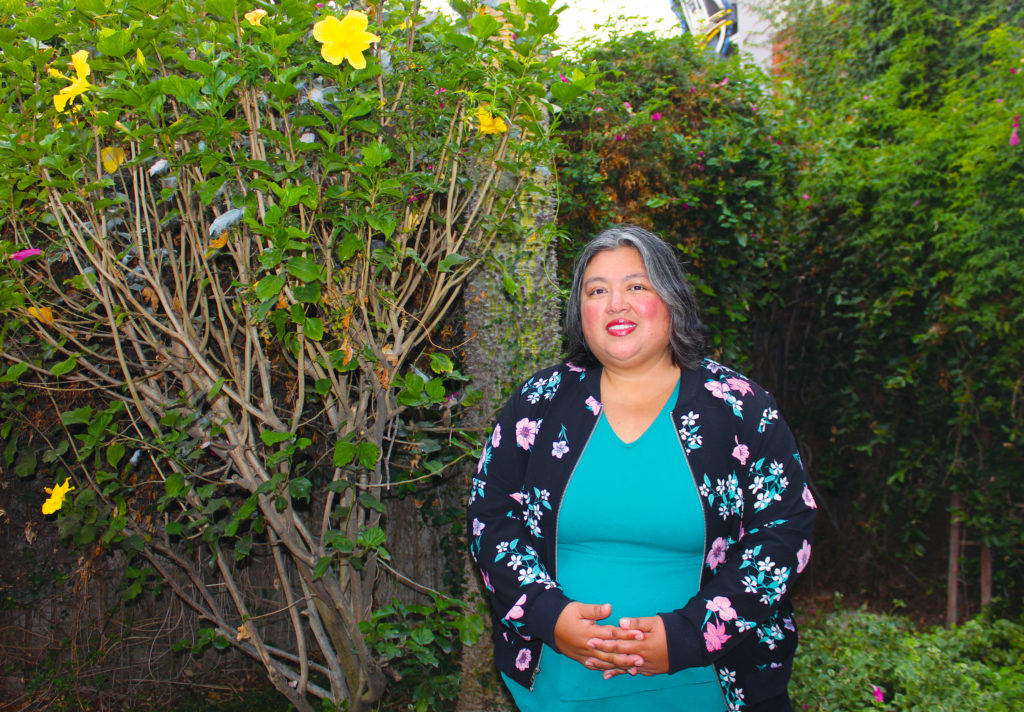With colorful murals going up year after year, internationally acclaimed musicians visiting the city to perform and the Long Beach Museum of Art’s new campus opening downtown, it’s an exciting time for art enthusiasts in the city. “The arts are quite vibrant in Long Beach right now,” Griselda Suarez, executive director of the Arts Council for Long Beach (ACLB), told the Business Journal. The ACLB is a nonprofit that promotes, advocates for and helps fund the arts in Long Beach.

As the visibility of Long Beach as a creative hub increases, more artists are encouraged to stay in Long Beach and contribute to the local art scene. This trend is particularly noticeable in the visual arts, Suarez noted. The work of local visual artists has become popular with both public and private clients eager to add a local touch to their projects. The Metro Blue Line improvement project, which included adding artworks from Long Beach-based visual artists to local stations, is one example. So is the art in and around the Long Beach Exchange’s food court, The Hangar, Suarez noted. “There’s a lot of art that they’ve incorporated,” she said.
New developments, like the Long Beach Exchange, can provide an opportunity for artists to cash in on their talent and skills. But as such projects begin to change the face of neighborhoods across the city, it’s important to ensure that cultural spaces are created and preserved, Suarez noted. In some cities, developers are incorporating permanent spaces for public art into new residential or commercial projects, an effort Suarez said she would like to see replicated in Long Beach.
“It’s a great way to embrace the culture that’s there and make sure that the residents feel that their neighborhood remains intact, while also bringing in new artists,” Suarez said. “Even if real estate [values] rise, the arts and culture practices that are in that neighborhood will be secured if there’s a permanent space.”
Suarez said she feels encouraged by the interest both private businesses and city leadership have shown in working with the creative community, be it through public art or educational programming.
On the city’s side, Suarez highlighted the Percent for the Arts program, which is entering its second year of funding through the city’s FY 2020 budget. The program, which was approved by the city council in December 2016, levies a 1% assessment on new capital projects with a cost of construction exceeding $100,000. A majority of revenues (60%) goes to the ACLB for the creation of public art and to fund small grants. The remaining 40% goes to local institutions, including the Long Beach Symphony Orchestra, International City Theatre and the Long Beach Playhouse.
A thriving arts scene, Suarez noted, is good for business, too. Organizations such as the Museum of Latin American Art (MOLAA) help bring in new audiences, Suarez said, while long-standing institutions like the Long Beach Opera continue to attract visitors. “All these organizations, together, are bringing in millions of dollars, and that is an amazing part of the economy,” she noted. “They’re attracting buyers, they’re attracting diners, through the arts.”
Every year, Southern Methodist University (SMU) in Dallas, Texas, provides a report of attendance numbers, revenues and expenditures reported by arts institutions across the country in an effort to help organizations make data-driven decisions and support their applications for funding with localized data. According to attendance numbers included in SMU’s DataArts report for the 2018 fiscal year, Long Beach arts institutions brought in at least 408,750 in-person participants for lectures, festivals, field trips and performances in FY 2018.
An investment in the arts, Suarez noted, is an investment in the future vitality of the city. “The [children] that many of our organizations serve, are really the future audiences and residents of Long Beach, who need to feel invested in their city, in their neighborhood and small local businesses,” she said. Art also has the capacity to breathe life and character into new commercial, residential or civic developments. “Residents don’t only want to eat something and drink good coffee, they also want to engage and have a neighborhood feeling,” Suarez explained. “And that’s where art becomes really important.”
As Long Beach continues to grow, what role does art play in the city’s development and what should be done to ensure that a thriving art scene is part of its future? The Long Beach Business Journal posed this question to those leading some of the city’s major arts institutions, and received the following responses.
 caryn desai
caryn desai
Artistic Director, Producer
International City Theatre
I cannot imagine a better sales pitch to attract new residents and businesses than to have the ability to boast about a thriving art scene in a community. It speaks to quality of life issues. The arts inspire, bring people together and ensure a more educated and more harmonious society. A vibrant community is not just about a place to live, shopping and restaurants, but they are certainly necessary partners – along with the arts – in developing Long Beach. The arts energize a city and all stakeholders who value a safer, kinder community should promote and support a thriving arts scene. I know for International City Theatre – like many of our arts partners in Long Beach – it’s also about our youth and arts education, providing access and training. Not because we necessarily expect them to become artists, but because of the many other skills they learn through the arts, including creative thinking, working together, discipline, and finding a joyful, positive outlet for expression. These are skills we all need and sometimes, through a play about someone who is different, we are reminded of our shared humanity. However, as [the director of] a professional theatre celebrating its 35th Anniversary in 2020, I can attest to the fact that it is never easy to do what we do but it is important. And what a wonderful dream it would be to have the resources to continue to grow and thrive! That idea excites me more than I can express – just thinking about what we could do!!
 Paul Garman
Paul Garman
Executive Director/Producer
Musical Theatre West
Long Beach is blessed to have a very active arts community, with major arts groups, dance companies and a wide variety of individual artists as well as museums. These are key to the continued growth and expansion of Long Beach as a thriving community. Arts and culture have always been an important part of community revitalization throughout the U.S.
Collaboration and partnerships between local arts groups are crucial in order to continue to grow. Increased city support is always important, but [finding] new ways to reach individual and corporate donors is also vital to each organization’s survival.
Programs for young people must continue to expand and include all segments of our community, introducing them to the rich variety of arts communities that we have in Long Beach. The cultivation of new audiences must always be a key priority, as many of the arts groups attract the same patrons, so instilling a love of the arts in our young people is vital to our growth.
A key challenge I see is to make our community more aware of the wonderful opportunities they have for arts experiences in Long Beach and discovering the most effective way to do that. Perhaps a Long Beach arts day or weekend, or some sort of a festival to really let the general public know the variety of opportunities they have.
 Martin Haselböck
Martin Haselböck
Musical Director
Musica Angelica
Art is a key element in a city’s quality of life and the well-being of its residents. For a city to develop and grow in a positive way, [it] requires strong connections between its citizens. Art provides solid human connections. Studies have proven that the quality of a city’s arts scene has a substantial impact, not only on the community’s quality of life and desirability, but also on its economic development. Cities with major artistic offerings draw residential and tourism development. Music is a powerful art which brings together people from diverse backgrounds, bridging language, emotions, and cultural differences.
Ensuring that Long Beach’s arts scene continues to thrive is vital to our city’s well-being and future growth. And the way to ensure that future growth is through arts education. It is important for our schools and arts organizations to support educational programs [that] provide our children with a vision for a promising future.
Musica Angelica provides opportunities for children to attend and enjoy the Orchestra’s concerts and attend music educational programs. The goal is to instill a lifelong love of great music, so our next generations will continue to be positively impacted and enlightened by their artistic experiences.
 Jan Hower
Jan Hower
President
Long Beach Camerata Singers
Long Beach Camerata Singers provide professional-level choral music to our city and serve as the symphony chorus for the Long Beach Symphony. Long Beach is now one of only three cities in Southern California to have a symphony chorus. This combination allows our audiences to enjoy a large repertoire of important choral/orchestral works that haven’t been performed in the city for over a decade.
In addition, Camerata performs its own series of concerts, including our Peace Project, Handel’s Messiah and Evening of Song. When a chorus sings, the sound proceeds from their bodies to your ears, a direct connection between the performers and the audience. New choral composers are exploding on the scene with boundary-pushing compositions, addressing social concerns and the human condition. Choral music evokes a deeply emotional response in our listeners.
Support for the arts needs to come from many sectors, including municipal support, foundations, individual giving, ticket sales and sponsorships. The good news is that the arts are thriving. But that’s also the bad news, because there is a lot of competition for the resources that keep us afloat. Municipal support is the one area that could be expanded: an affirmative program that recognizes the contributions of the arts that make our city an attractive destination.

Megan Kline Crockett
Executive Director
Carpenter Performing Arts Center
California State University, Long Beach
The arts play a vital role in a city’s development, impacting the culture, education and economy. Our nonprofit arts groups are not only a powerful economic force, more importantly, they help to educate and inspire our community. A thriving art scene is essential to a city because of the inherent and intangible value of the arts: to enhance life, provide entertainment, and define our community identities and values.
To ensure a thriving arts scene is a part of Long Beach’s future, it takes both public and private investment in the arts. Here at the Carpenter Center, we believe that access to arts activities should be available to all members of our community. In addition to our regularly presented season, we created Arts for Life, a curated season of free arts activities.
Through Arts for Life, over 3,000 Long Beach Unified [School District] school children participate in artist workshops and come to the Carpenter Center for performances every year. Studies have shown that literacy and graduation rates increase when a child has access to arts education. In addition, we present over 20 performances, lectures, or readings each season that are free and open to the public. These events not only provide an educational and cultural benefit but also bring people to Long Beach – making our city a more vibrant and diverse place to live, learn and grow.

Kelly Lucera
President
Long Beach Symphony
As a proud 32-year resident of this city, I greatly enjoy the varied arts and entertainment options in our city, which create community, provoke interesting conversations, promote reflection and foster creativity.
As the Symphony’s President, I believe it’s incumbent upon arts organizations to serve and engage the broader community. Changing demographics require arts organizations to maintain their relevance through innovative programming and solutions . . . to address the sociological challenges inherent in a major urban city. The Symphony’s music education programs serve over 200,000, or nearly half of this city’s population, annually. We remain committed to removing barriers, engaging the wonderfully diverse population [of Long Beach] and ensuring equity in access for our entire community.
All great cities have great art, which – of course – increases revenue through an enhanced quality of life appeal for residents, businesses and tourists. We are fortunate to have such a thriving arts scene in Long Beach which must be supported through attendance and contributions by a broad and diverse sector of its community. To ensure longevity, great city governments provide substantial financial support to its arts institutions which are responsible for generating revenue for tourism and hospitality, as well as jobs for its venues, employees and artists. We are grateful to the Arts Council for Long Beach and the Mayor’s 1% for the Arts initiative which are good first steps in helping to ensure that a thriving arts scene is part of this city’s future.
Long Beach is turning into one of the most vibrant cities in Southern California. We have it all – an enormous and beautiful beach, an airport, the university, the port, great leadership and a wonderful array of arts to offer our residents and guests. The arts are the soul and conscience of the city and they offer peaceful gathering opportunities in our sometimes baffling world.
 Fran Lujan
Fran Lujan
Director/Curator
Pacific Island Ethnic Art Museum
Art illuminates a remarkable resource for understanding histories, cultures and transformations that are taking place. For our diverse Pacific Islander communities, who have been celebrating their heritage in California and in the City of Long Beach, the arts are not compartmentalized, they are a part of the very fabric of our people’s existence and values. As the city continues to build its creative ecology, it must recognize that the arts of the Pacific Islanders are more than a festival. It must bring arts back into education, creativity shouldn’t be an elective. It must make residential places affordable for artists to live here.
 Madison Mooney
Madison Mooney
Executive Director
Long Beach Playhouse
To me, the art scene is the beating heart of a city and its community. The arts, theatre specifically, can be entertaining, empowering, therapeutic, inspiring, mind-opening, a connection, a release and a reflection of what a city values. The arts better everyone’s lives.
Art is not created in a vacuum; it takes a village, and an observer to finish the formula. Everyone can play a part in sustaining a thriving art scene here in Long Beach. Not just the city at large, showing support and creating partnerships with artists and organizations, but every single resident. Everyone can be an ambassador for their favorite artist or arts organization by supporting their work, and sharing their work with friends and family.
 Jennifer Rivera
Jennifer Rivera
Executive Director & CEO
Long Beach Opera
The arts scene in any city is a very important factor in the economic growth and development of that city. Arts organizations not only provide jobs and important cultural distinctions to the city in which they reside, but they can also drive tourism and bring positive attention to the city.
While Long Beach shares the population size of cities like Atlanta, the budgets for Long Beach’s arts organizations are far below many cities with comparable populations. However, Long Beach’s arts organizations continue to bring distinction and attention to the city itself. Long Beach Opera demonstrated this fact when articles appeared in The New York Times, The New Yorker, The Washington Post, and the Los Angeles Times featuring our world premiere opera this past June. From coast to coast, people read the words “Long Beach” and associated those words with artistic innovation.
In order to continue the growth of the arts sector residents, businesses and the government must work together to ensure that there is adequate funding for these institutions, and residents of Long Beach must increase their patronage of and participation in the amazing array of local arts offerings. Residents should also be made aware that a strong cultural footprint increases any city’s worth and [should] be encouraged to support their local arts organizations as a point of civic pride. I would also advocate for strong support of arts education in local schools, which allows young people an access point to create future arts lovers and supporters.
Editor’s Note: A previous version of this story stated that Long Beach arts institutions welcomed 12,986 in-person participants in FY 18. This number reflected the attendance of events by the Long Beach Council for the Arts alone. The article has been updated to include total attendance for all reporting institutions.
